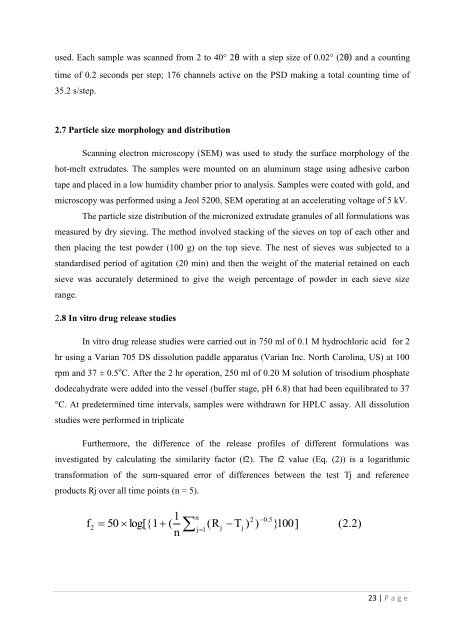Development of hot-melt extrusion as a novel technique for the ...
Development of hot-melt extrusion as a novel technique for the ...
Development of hot-melt extrusion as a novel technique for the ...
Create successful ePaper yourself
Turn your PDF publications into a flip-book with our unique Google optimized e-Paper software.
used. Each sample w<strong>as</strong> scanned from 2 to 40° 2 with a step size <strong>of</strong> 0.02° (2) and a countingtime <strong>of</strong> 0.2 seconds per step; 176 channels active on <strong>the</strong> PSD making a total counting time <strong>of</strong>35.2 s/step.2.7 Particle size morphology and distributionScanning electron microscopy (SEM) w<strong>as</strong> used to study <strong>the</strong> surface morphology <strong>of</strong> <strong>the</strong><strong>hot</strong>-<strong>melt</strong> extrudates. The samples were mounted on an aluminum stage using adhesive carbontape and placed in a low humidity chamber prior to analysis. Samples were coated with gold, andmicroscopy w<strong>as</strong> per<strong>for</strong>med using a Jeol 5200, SEM operating at an accelerating voltage <strong>of</strong> 5 kV.The particle size distribution <strong>of</strong> <strong>the</strong> micronized extrudate granules <strong>of</strong> all <strong>for</strong>mulations w<strong>as</strong>me<strong>as</strong>ured by dry sieving. The method involved stacking <strong>of</strong> <strong>the</strong> sieves on top <strong>of</strong> each o<strong>the</strong>r and<strong>the</strong>n placing <strong>the</strong> test powder (100 g) on <strong>the</strong> top sieve. The nest <strong>of</strong> sieves w<strong>as</strong> subjected to <strong>as</strong>tandardised period <strong>of</strong> agitation (20 min) and <strong>the</strong>n <strong>the</strong> weight <strong>of</strong> <strong>the</strong> material retained on eachsieve w<strong>as</strong> accurately determined to give <strong>the</strong> weigh percentage <strong>of</strong> powder in each sieve sizerange.2.8 In vitro drug rele<strong>as</strong>e studiesIn vitro drug rele<strong>as</strong>e studies were carried out in 750 ml <strong>of</strong> 0.1 M hydrochloric acid <strong>for</strong> 2hr using a Varian 705 DS dissolution paddle apparatus (Varian Inc. North Carolina, US) at 100rpm and 37 ± 0.5 o C. After <strong>the</strong> 2 hr operation, 250 ml <strong>of</strong> 0.20 M solution <strong>of</strong> trisodium phosphatedodecahydrate were added into <strong>the</strong> vessel (buffer stage, pH 6.8) that had been equilibrated to 37°C. At predetermined time intervals, samples were withdrawn <strong>for</strong> HPLC <strong>as</strong>say. All dissolutionstudies were per<strong>for</strong>med in triplicateFur<strong>the</strong>rmore, <strong>the</strong> difference <strong>of</strong> <strong>the</strong> rele<strong>as</strong>e pr<strong>of</strong>iles <strong>of</strong> different <strong>for</strong>mulations w<strong>as</strong>investigated by calculating <strong>the</strong> similarity factor (f2). The f2 value (Eq. (2)) is a logarithmictrans<strong>for</strong>mation <strong>of</strong> <strong>the</strong> sum-squared error <strong>of</strong> differences between <strong>the</strong> test Tj and referenceproducts Rj over all time points (n = 5).f1 50 log[{1 (nn2 0.52 ( R ) )j 1 jTj}100](2.2)23 | P a g e
















